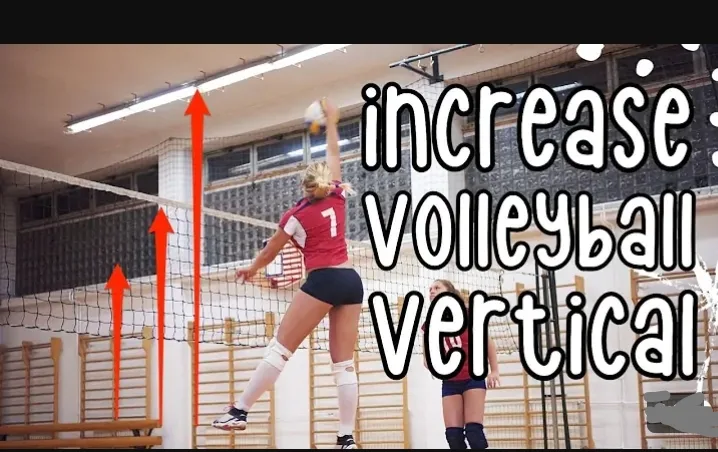To increase your vertical jump for volleyball, you must first of all understand the basics of vertical jump and then engage in tedious jump exercises like jumping rope and box jump training.
Whether you’re spiking, blocking, or setting, vertical jumping is one of the most critical skills in volleyball.
Increasing your jump height will not only improve your performance but will also open up more opportunities on the court, giving you an edge in hitting, blocking, and defense.
This informative article will guide you on how to increase your vertical jump for volleyball, following a few tips, techniques, and volleyball exercises.
The Role of Vertical Jump in Volleyball
In volleyball, vertical jump height affects almost every aspect of play. The higher you can jump, the greater your chances of successfully spiking, blocking, or hitting over the net. A vertical jump isn’t just about pure height; it’s also about explosive power, control, and timing.
By increasing your vertical jump, you’ll become a more versatile volleyball player capable of executing difficult shots, reaching over blockers, and reacting quickly to opponents’ moves.
Understand the Basics of Vertical Jump in Volleyball
The vertical jump in volleyball relies on three main components: leg power, core strength, and coordination.
- Leg Power: Your legs are the primary source of the explosive force you need to get off the ground.
- Core Strength: A strong core helps stabilize your body, allowing for greater control during jumps and landings.
- Coordination: Timing and body coordination are essential for successful jumps, especially when aiming for specific points on the court.
Exercise to Increase Vertical Jump for Volleyball
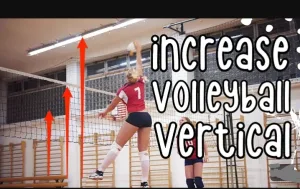
1. Leg Strength Exercises
Your legs are your powerhouses for jumping, so increasing strength in your quadriceps, hamstrings, and calves will provide a strong foundation for your vertical jump.
Below are a few volleyball exercises that are recommendable for building leg strength for a vertical jump:
-
Squats
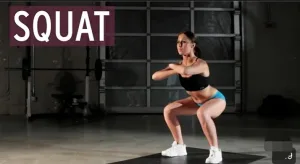
Squats are one of the best exercises for building leg strength, targeting your quadriceps, gluts, and hamstrings. They not only enhance power but also improve stability and balance.
How to Perform Squats Exercise to Improve Vertical Jump?
Stand with your feet shoulder-width apart, lower your hips as if you’re sitting back into a chair, and push through your heels to return to the starting position. Focus on keeping your back straight and engaging your core.
-
Lunges
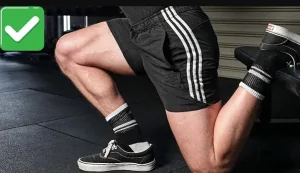
Lunges work similar muscle groups as squats but also engage your stabilizing muscles, improving balance and control during jumps.
How to Perform Lunge Exercise to Improve Vertical Jump?
Step forward with one leg and lower your hips until both knees are at 90 degrees. Push through the front heel to return to standing.
See Also: 8 best Plyometric Workouts for Volleyball Players
-
Calf Raises
Calf raises help develop explosive power and ankle strength, crucial for a quick and powerful jump.
How to Perform Calf Raises Exercise to Improve Vertical Jump?
Stand with your feet shoulder-width apart, rise onto the balls of your feet, and slowly lower back down.
2. Jumping Exercises
Plyometric exercises are specifically designed to increase explosive power, which translates directly into a better vertical jump. These exercises focus on fast, powerful movements that train your muscles to react quickly and explosively. Below are some plyometric exercises that are recommendable for building leg strength for a vertical jump:
-
Box jumps
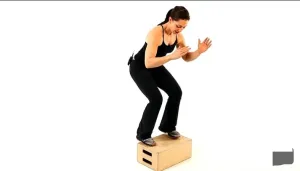
Box jumps are excellent for developing explosive leg power and can be tailored to match your current jump height.
How to Perform Box Jumps:
Stand in front of a sturdy box or platform. Lower into a squat, then jump up onto the box, landing softly. Step down and repeat.
-
Depth Jumps
Depth jumps are an advanced plyometric exercise that helps develop reaction speed and jump explosiveness.
How to Perform Depth Jumps:
Stand on a box, step off, and immediately jump up as soon as you hit the ground. Focus on minimizing ground contact time.
See Also: 10 Best Volleyball Strength Exercises for Beginners
-
Broad Jumps
Broad jumps are horizontal jumps that help improve leg power and stability, both essential for volleyball jumps.
How to Perform Broad Jumps:
Start in a squat position, explode forward with both legs, and land softly.
3. Flexibility Exercises
Flexibility allows for a full range of motion, helping you jump more efficiently and land safely. Focus on stretching exercises that target your calves, hamstrings, quads, and hip flexors, as these muscles are heavily engaged during jumps. A few exercises to help you in this aspect include:
-
Hamstring Stretch
Stretching your hamstrings improves leg flexibility, aiding in both the jump and landing phases.
How to Perform Hamstring Stretch:
Sit on the ground with one leg extended, reach for your toes, and hold the stretch.
Duration: Hold for 30 seconds on each leg.
-
Hip Flexor Stretch
The hip flexors are crucial for knee lift during jumps, and stretching them can increase your jump height.
How to Perform Hip Flexor Stretch:
Kneel on one knee, push your hips forward, and hold.
Duration: Hold for 30 seconds on each leg.
Read more: Volleyball Workouts at Home and the Gym (7-day plan)
How to Increase your Vertical Jump for Volleyball: Tips for Maximizing Vertical Jump Training
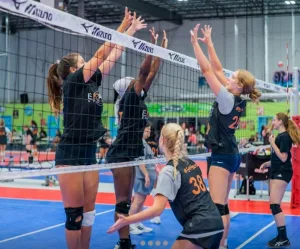
1. Maintain consistency
Training your vertical jump requires regular, consistent effort. Aim to include these exercises in your workout routine 2-3 times per week, allowing for rest days to avoid overtraining.
2. Focus on Proper Technique
While exercises like squats and plyometrics are effective, they should be done with the correct form to avoid injury. For beginners, it may be beneficial to work with a trainer to learn proper form.
3. Learn to Rest and Recover
Jump training puts a lot of stress on your muscles, tendons, and joints. Make sure you’re getting adequate rest and recovery, including stretching, foam rolling, and possibly using a recovery routine.
4. Utilize your progress.
As you progress, gradually increase the difficulty of your exercises. Use heavier weights for strength exercises, higher boxes for jumps, or add extra reps as your strength improves.
See Also: Best Volleyball Shoes 2025: Review of the Best Models
Conclusion
Increasing your vertical jump in volleyball isn’t an overnight achievement. Such achievements need time, dedicated training, consistency, and a well-rounded approach that includes strength, plyometric, and flexibility exercises. We believe these tips will help you to increase your vertical jump for volleyball.

